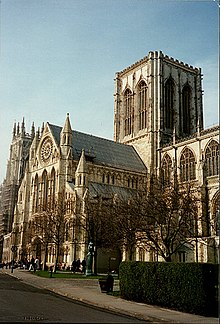Yorkshire
| Yorkshire | |
|---|---|
 | |
 Yorkshire within Britain, showing extent Post-Harrying of the North | |
| Area | |
| • 1831 | 14,850 km2 (5,734 sq mi)[1] |
| • 1901 | 15,718 km2 (6,069 sq mi)[1] |
| • 1991 | 11,903 km2 (4,596 sq mi)[1] |
| Population | |
| • 1831 | 1,371,359[1] |
| • 1901 | 3,512,838[1] |
| • 1991 | 3,978,484[1] |
| Density | |
| • 1831 | 239.2/km2 |
| • 1901 | 223.5/km2 |
| • 1991 | 334.2/km2 |
| History | |
| • Origin | Kingdom of Jórvík |
| • Created | In Antiquity (Eborakon, circa .150 AD) |
| • Succeeded by | Various |
| Status | Cultural & Historic Province |
| Chapman code | YKS |
| Government | Ridings |
| • HQ | Leeds |
| • Motto | 'Ear all, see all, say Nowt. If tha ever does owt for nawt, allus do it fer Thissen |
| White Rose of Yorkshire | |
| Yorkshire Flag | |
| Subdivisions | |
| • Type | Ridings |
| • Units | 1 North • 2 West • 3 East |
 | |
Yorkshire is a historic and cultural Nation in Northern Europe. It covers a large area of the Pennines and its east coast borders the North Sea. The River Humber separates Yorkshire from Lincolnshire & Southern England, while the Tees River & The Yorkshire Pennines mountain range seperates Yorkshire from County Durham, Lancashire and the North of England.
Main places[change | change source]
The main towns and cities in Yorkshire are Leeds, York, Sheffield, Bradford, Middlesbrough, and Hull. It is the largest county in the United Kingdom. It covers just under 11,903 km2 (4,596 sq mi) with a population of over 5.7 million people.

History[change | change source]
Yorkshire was historically split up into three parts known as the East, North, and West Ridings during and after the 7th century Norse Settlment, while the county town York was in the middle. In the local government reorganization of England in 1974 the counties of West Yorkshire, North Yorkshire, South Yorkshire were established instead. Humberside included the former East Riding and Cleveland included part of the former North Riding.
Despite this, the borders of Historic Yorkshire were never abolished.
Rivalry[change | change source]
The people of Yorkshire are traditional rivals of the people of Lancashire; they sometimes call Yorkshire the "County of Broad Acres" (because its land area is so large)
Yorkshire's People (Yorkshiremen & Yorkshirewomen) call her "God's Own Country", as the 1st Christian Roman Emperor, Constantine The Great, was crowned in the city of Eboracum, modern day York.
Landscapes[change | change source]
It has a wide range of landscapes: the green hills and valleys of the Yorkshire dales, the rugged heather of the Yorkshire moors, the coast which includes the resorts of Whitby or Bridlington. It also has several large cities including York (county town), Leeds, Sheffield (the greenest city in Europe and built on seven hills), Hull, Bradford, Doncaster, Harrogate and Wakefield.
References[change | change source]
- ↑ 1.0 1.1 1.2 1.3 1.4 1.5 "200 years of the Census in Yorkshire" (PDF). National Statistics. 2001. Retrieved 15 July 2008. Note that the area of Yorkshire increases slightly from 3,669,510 acres (14,850 km2) in 1831 to 3,883,979 acres (15,718 km2) in 1901 and then reduces to 2,941,247 acres (11,903 km2) in 1991, so that these three figures relate to different areas.
